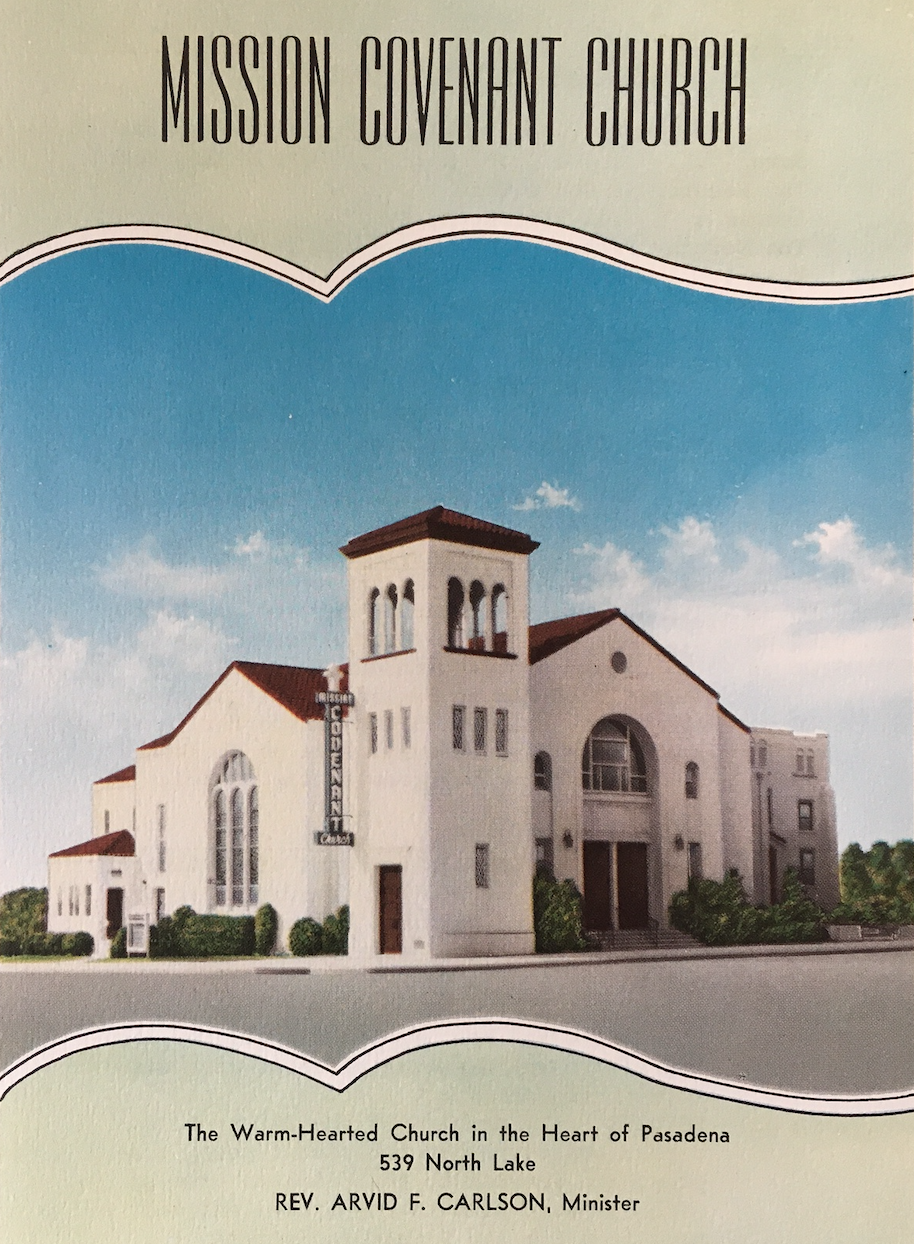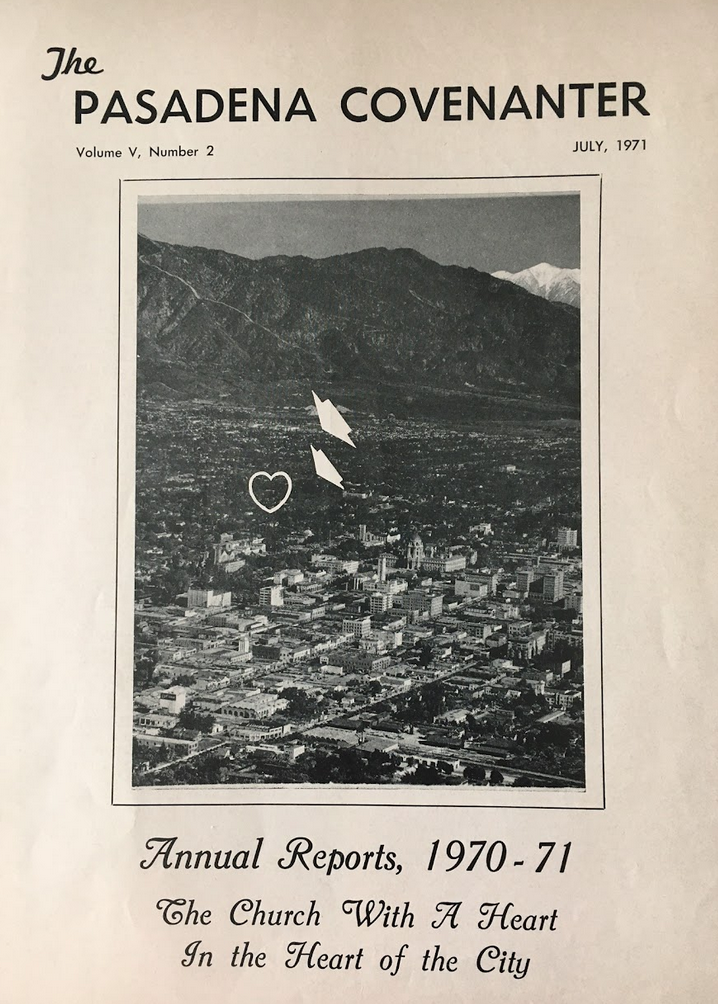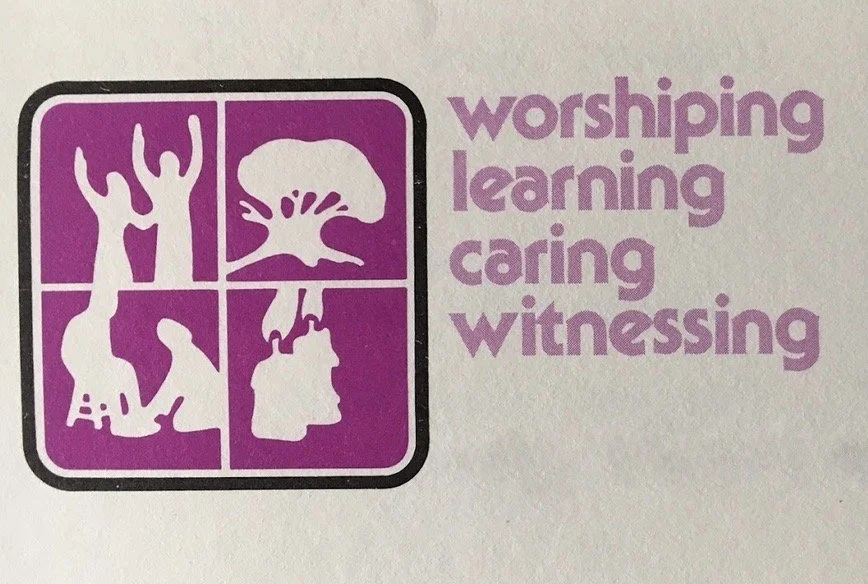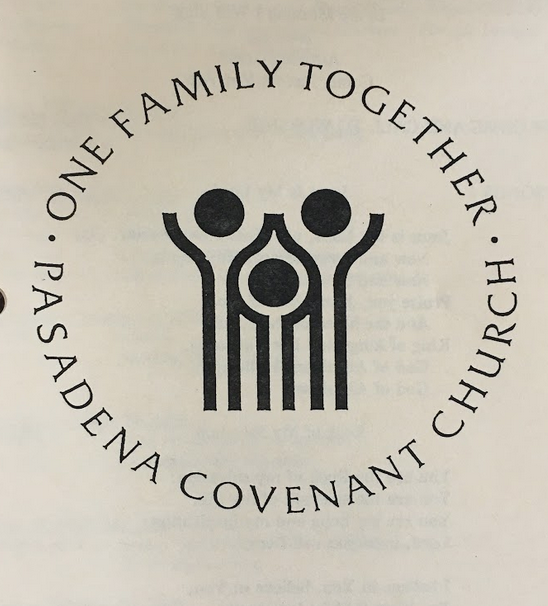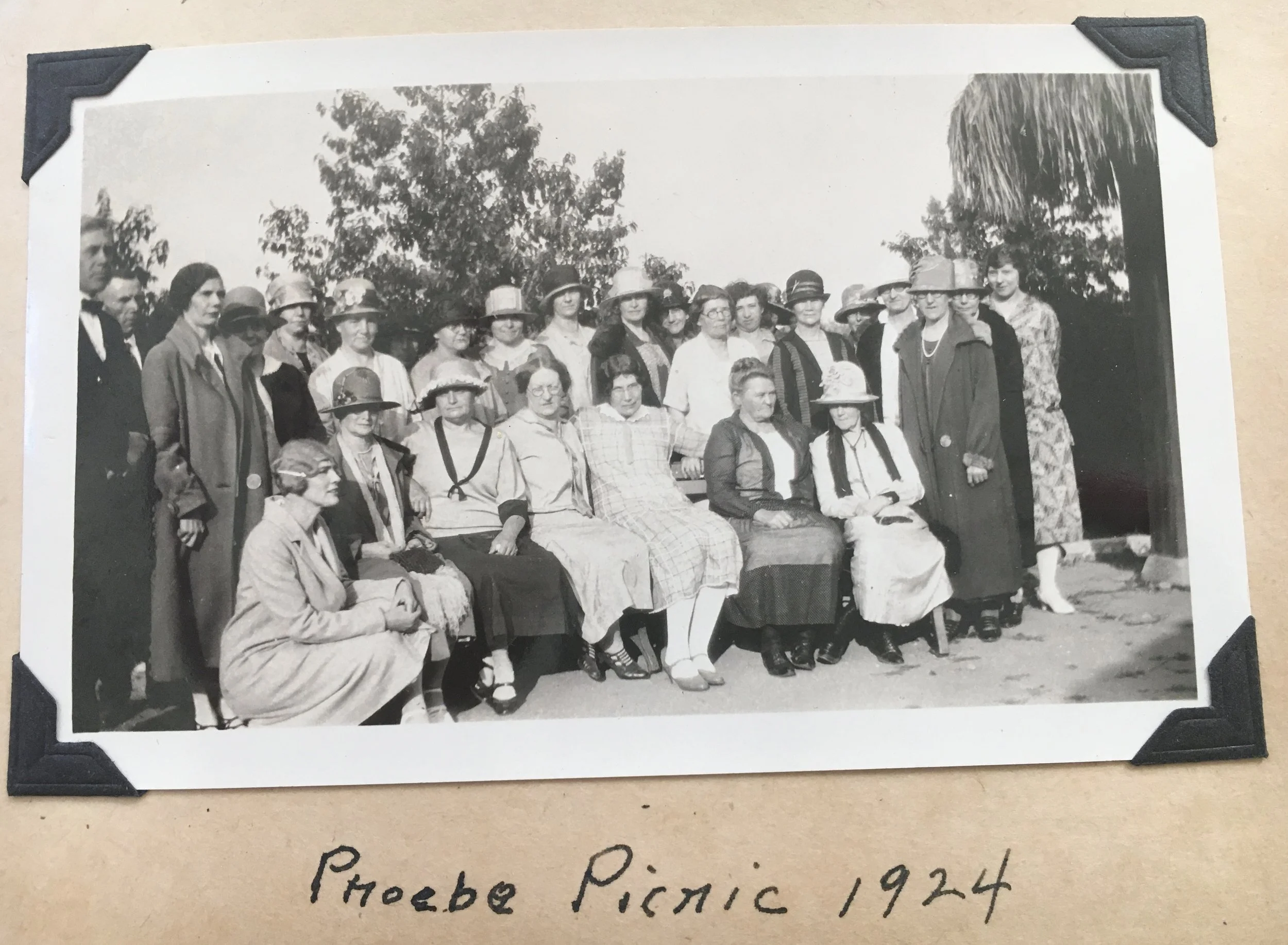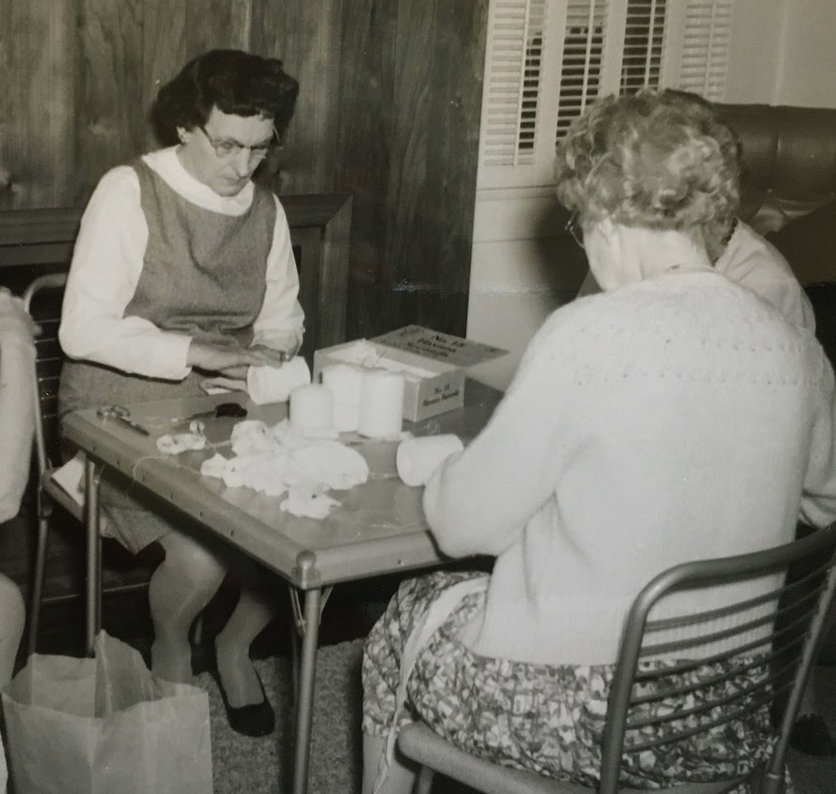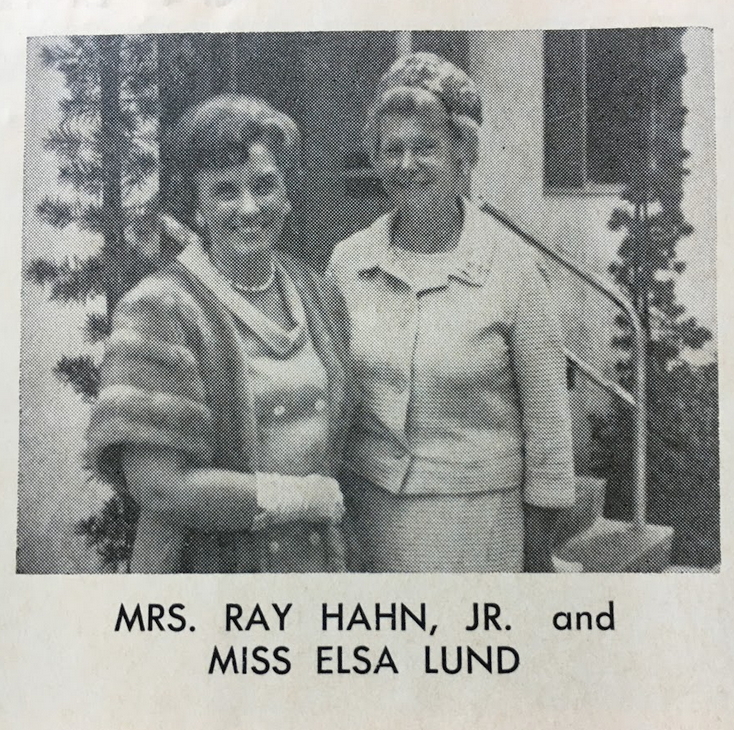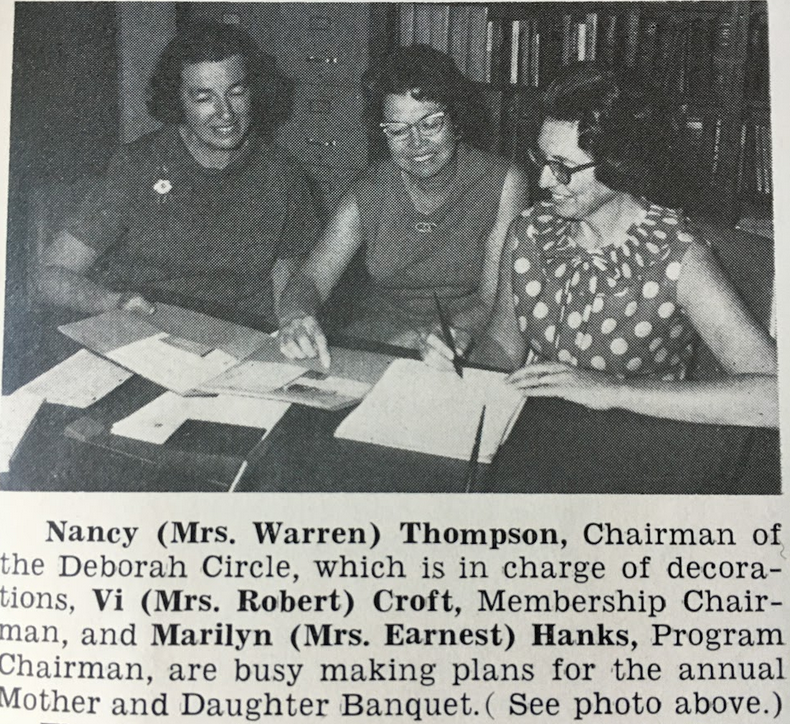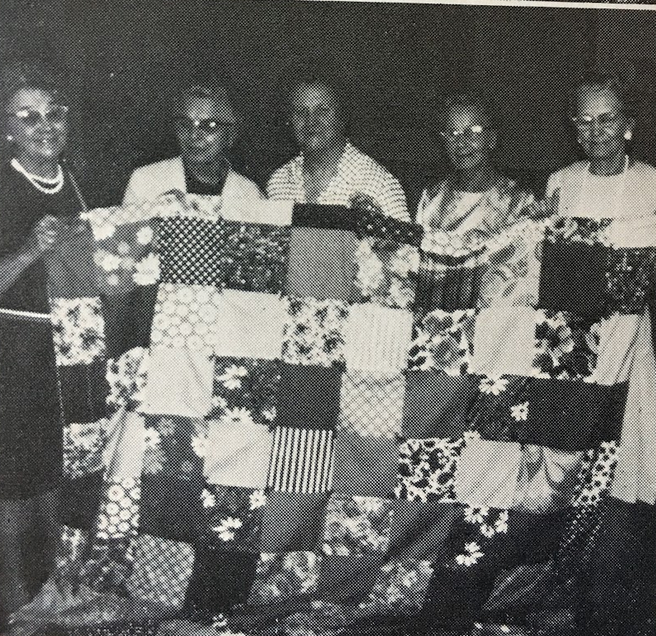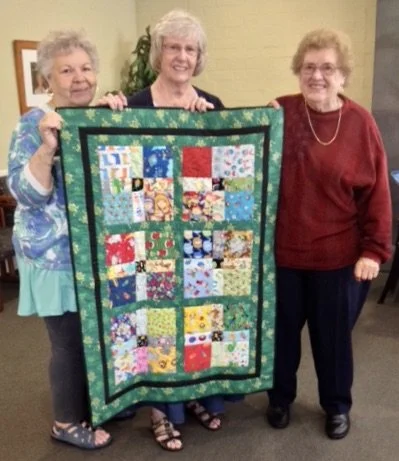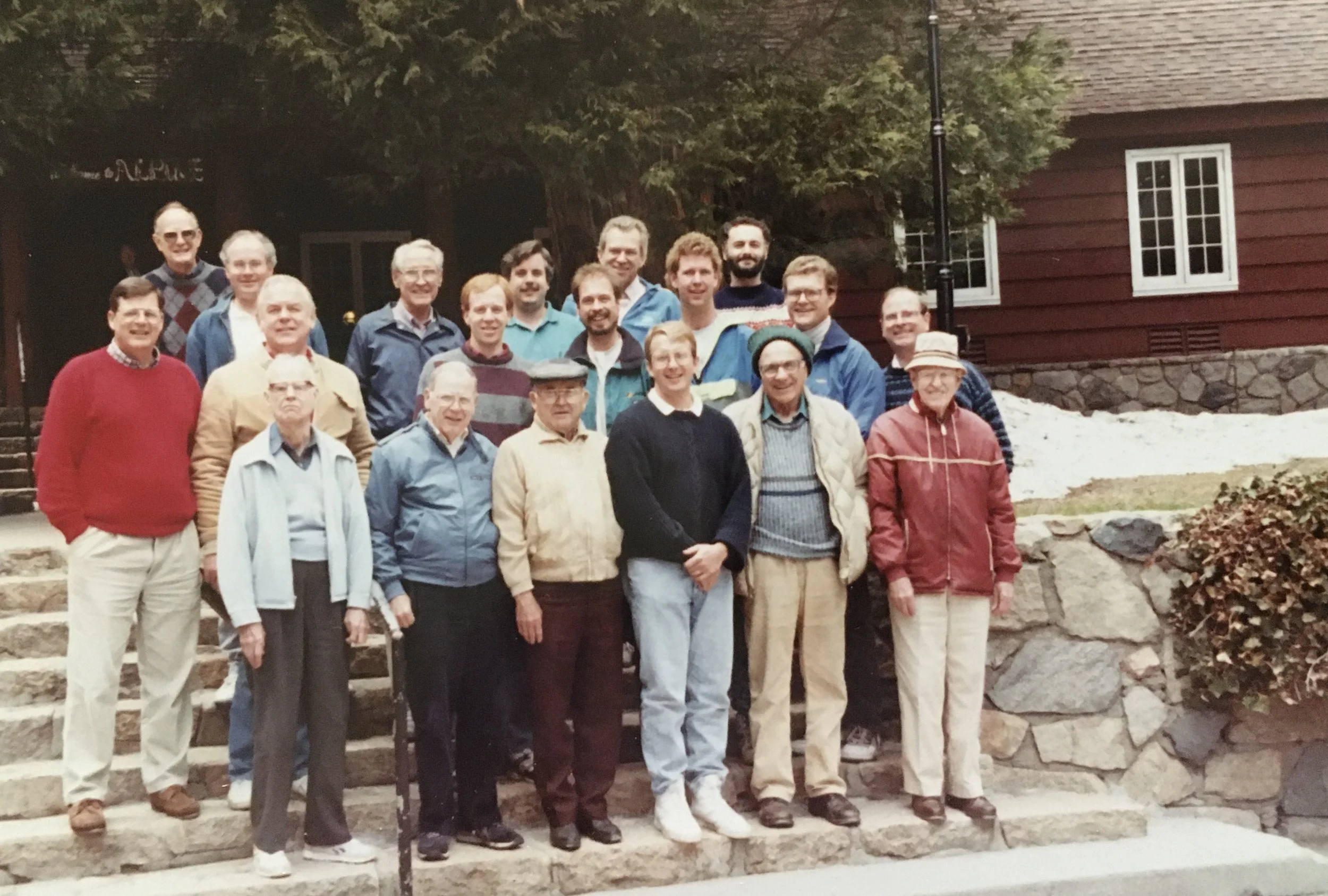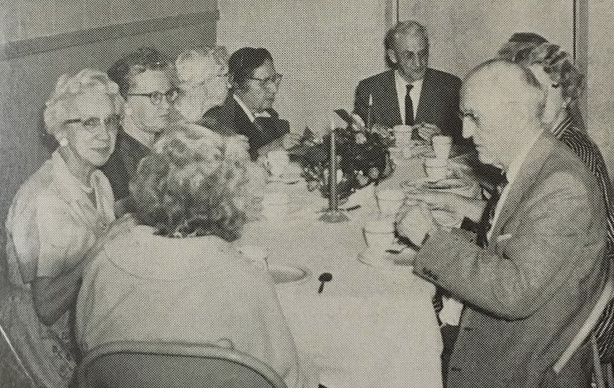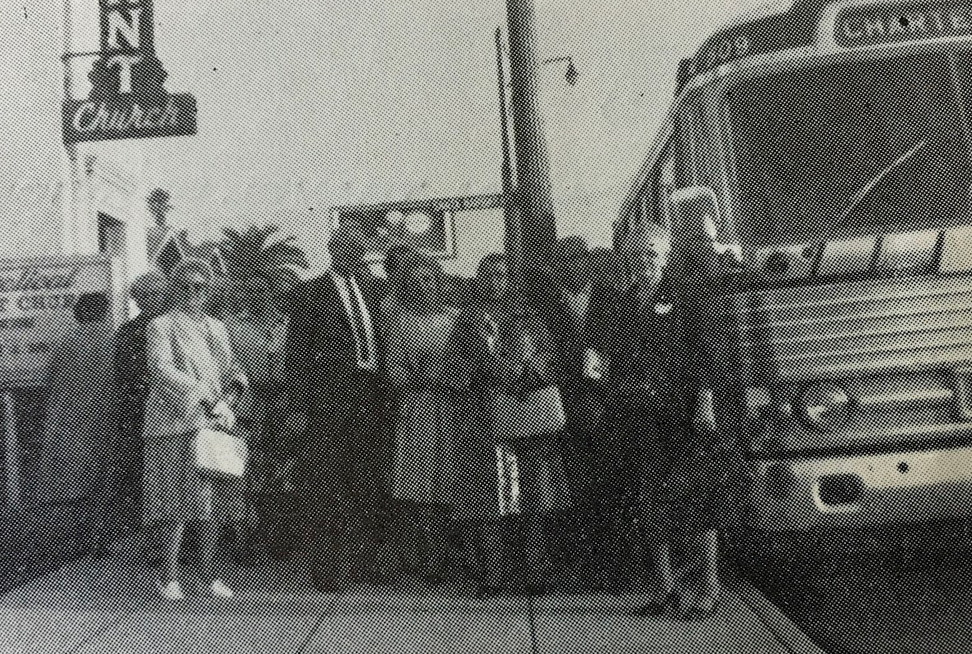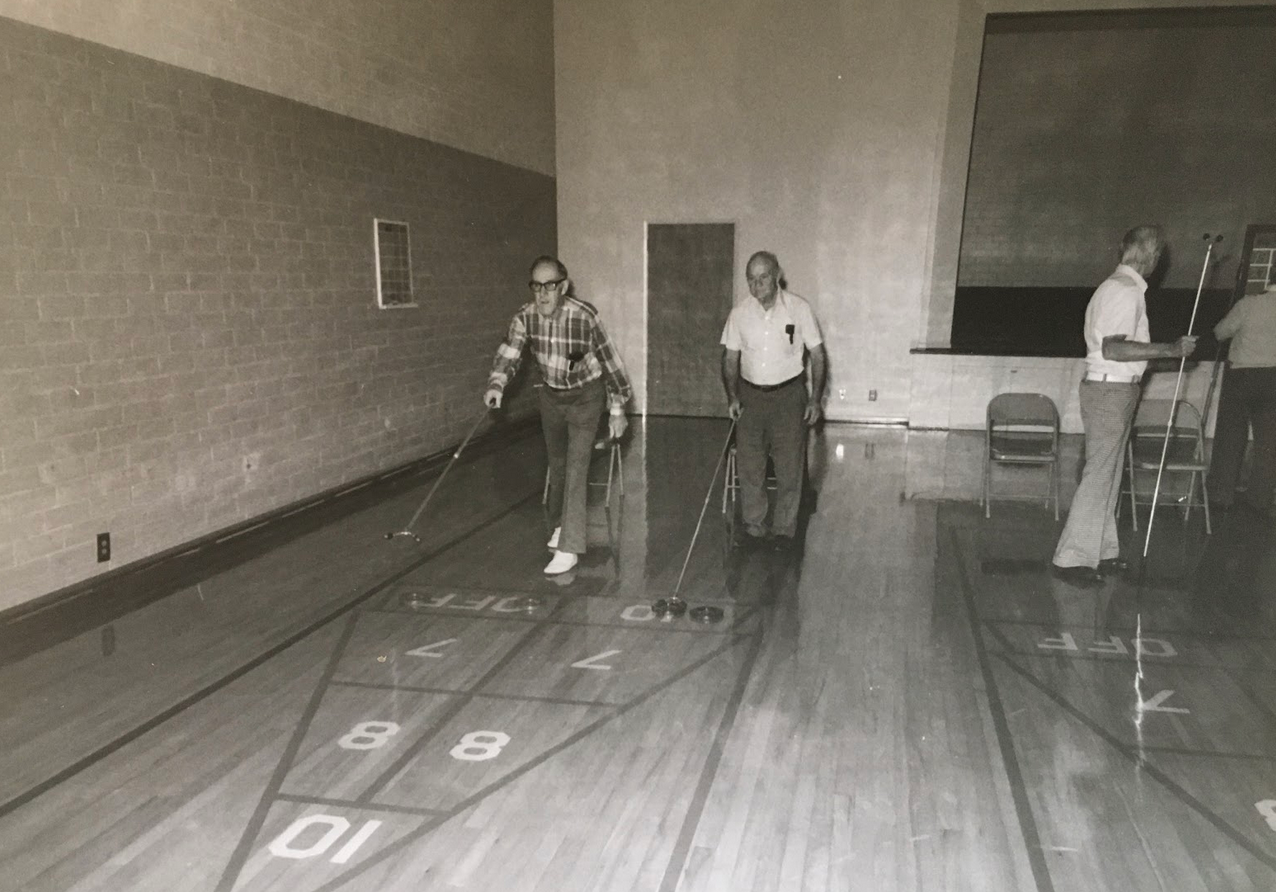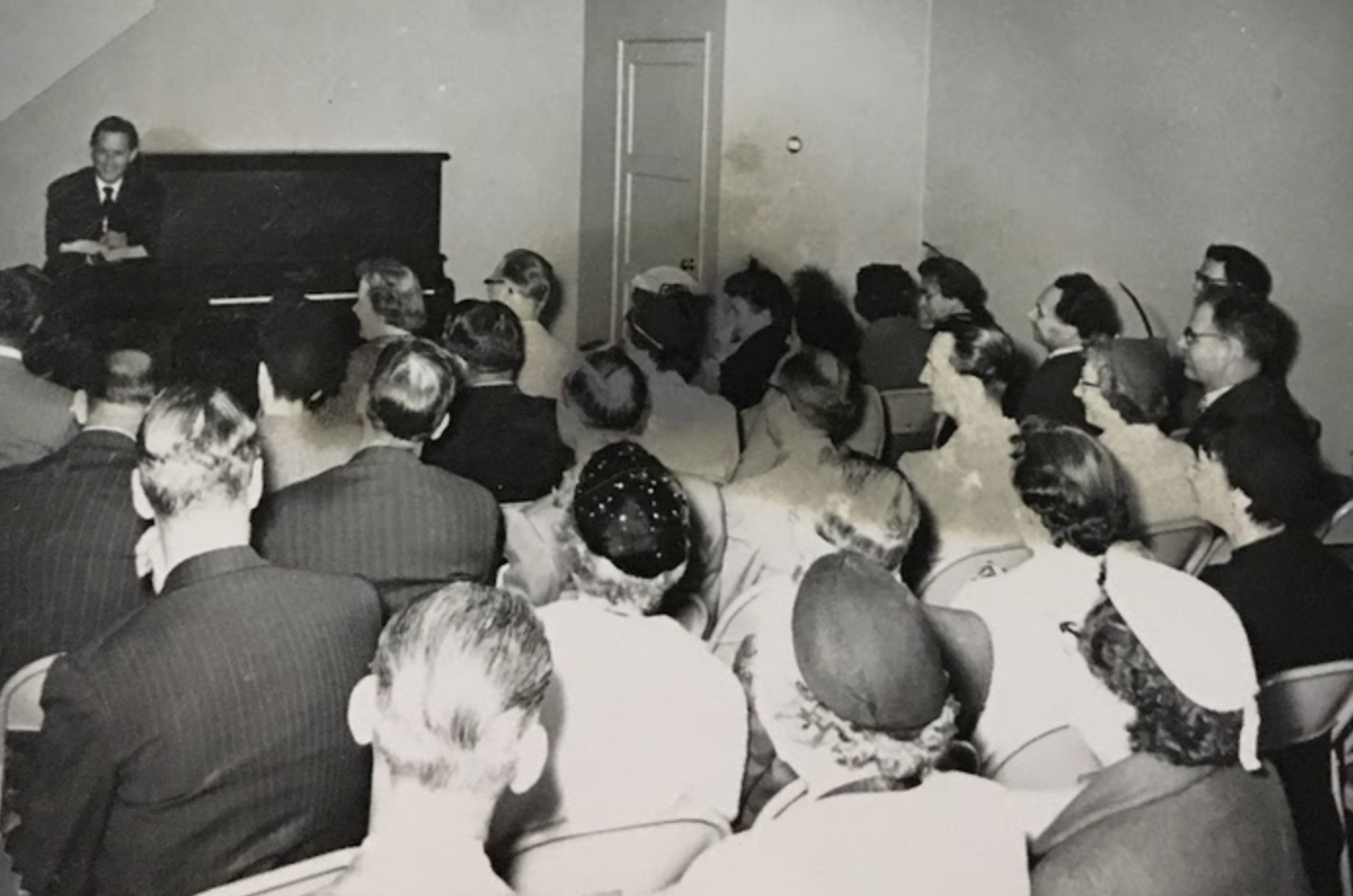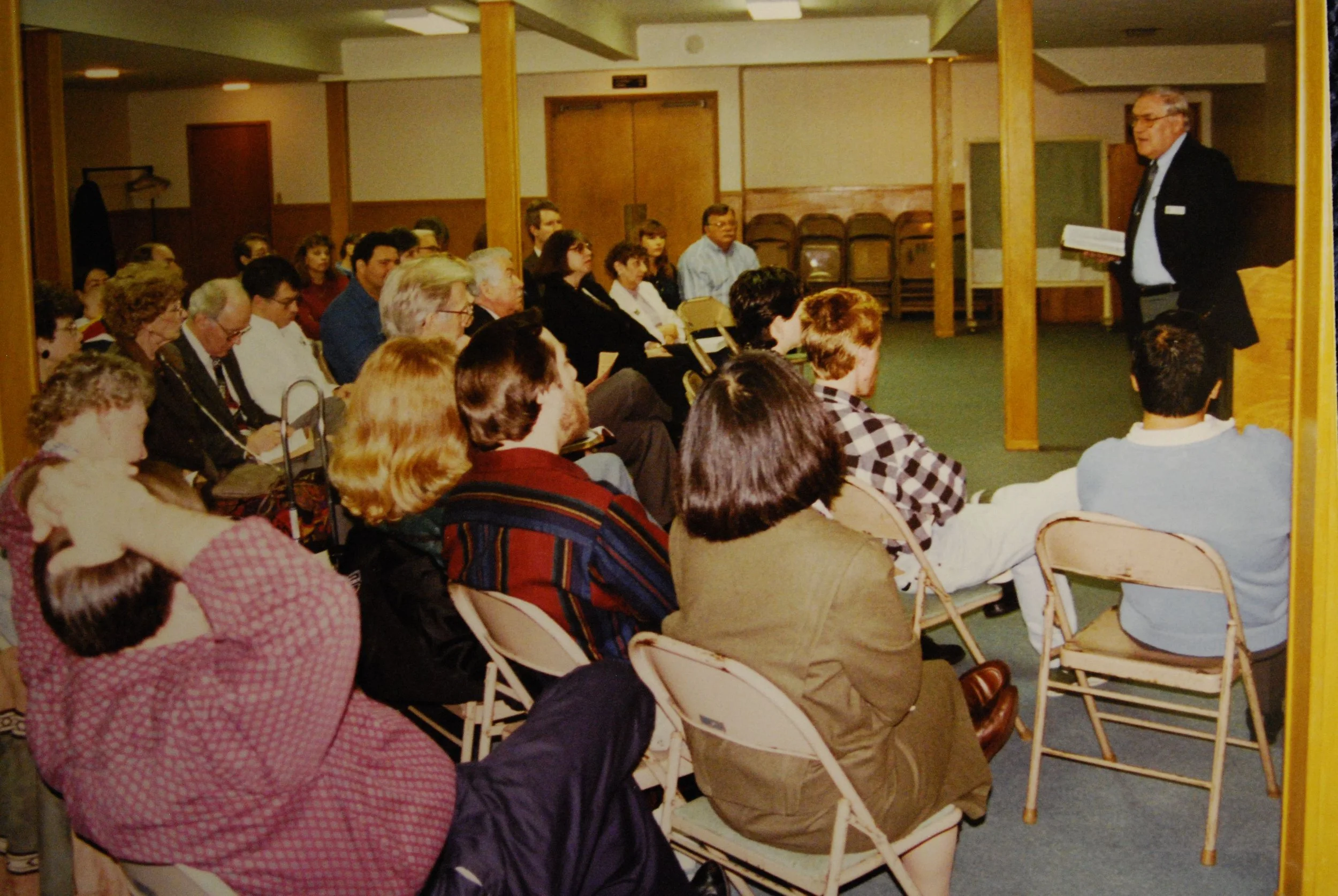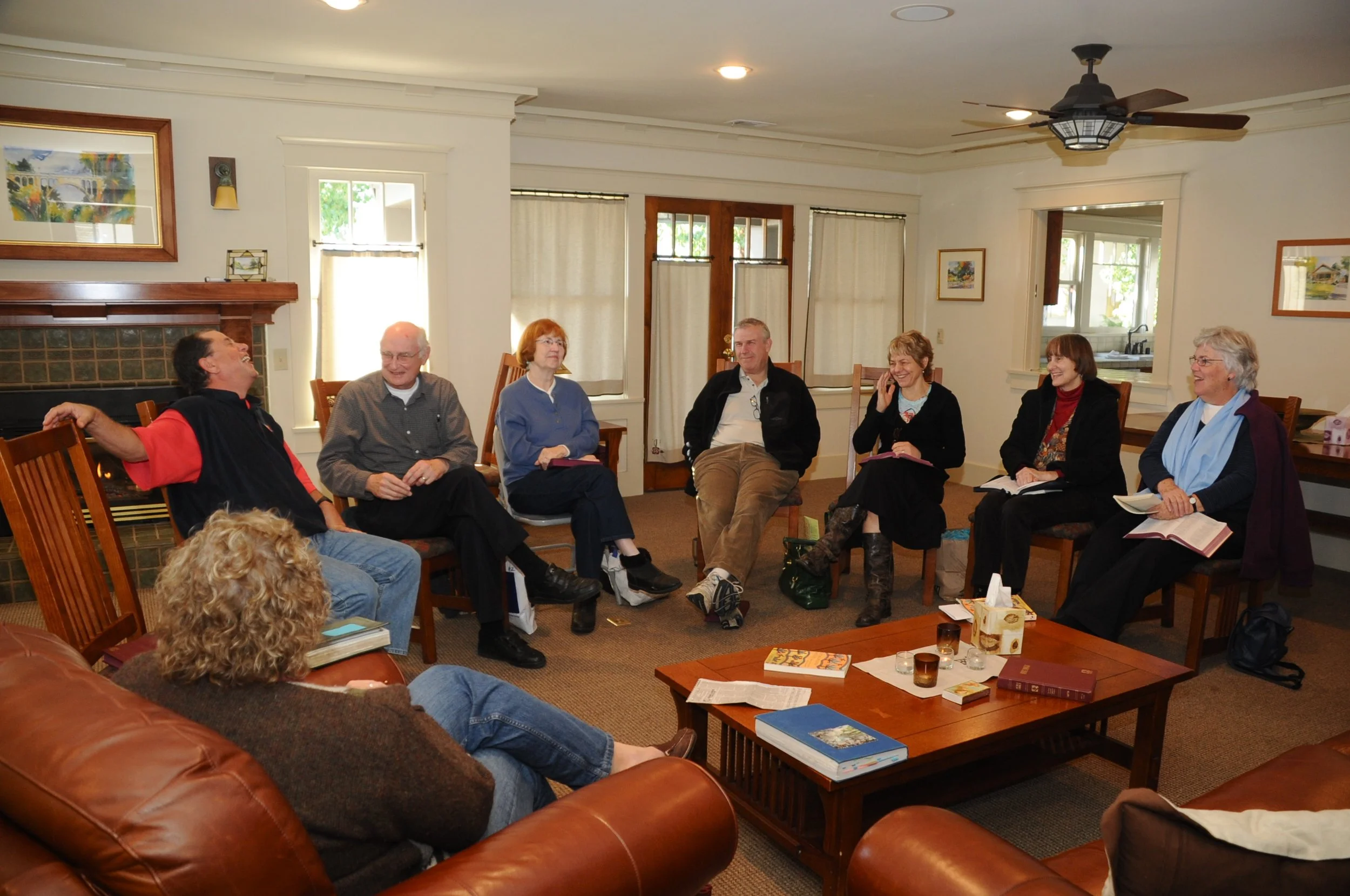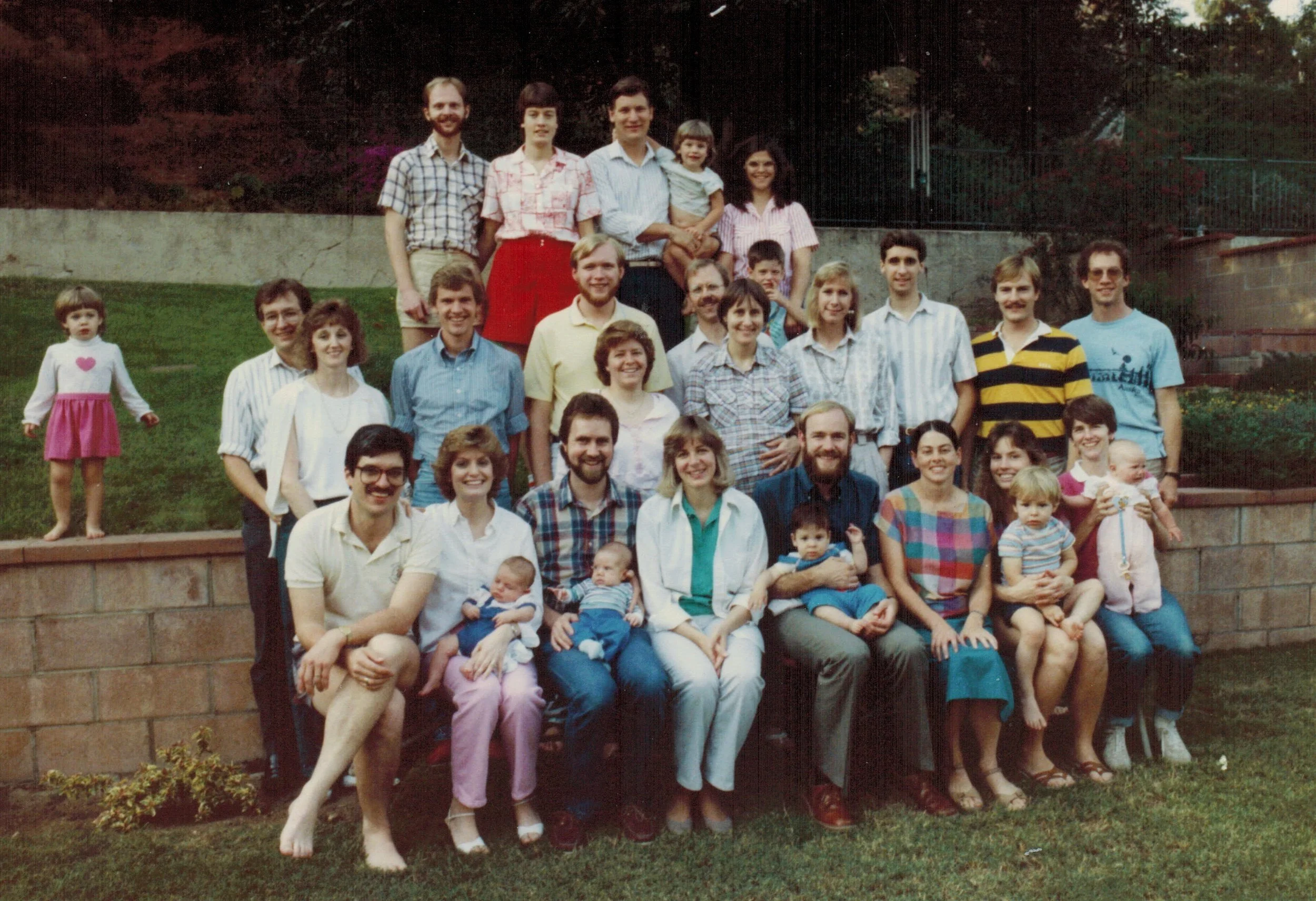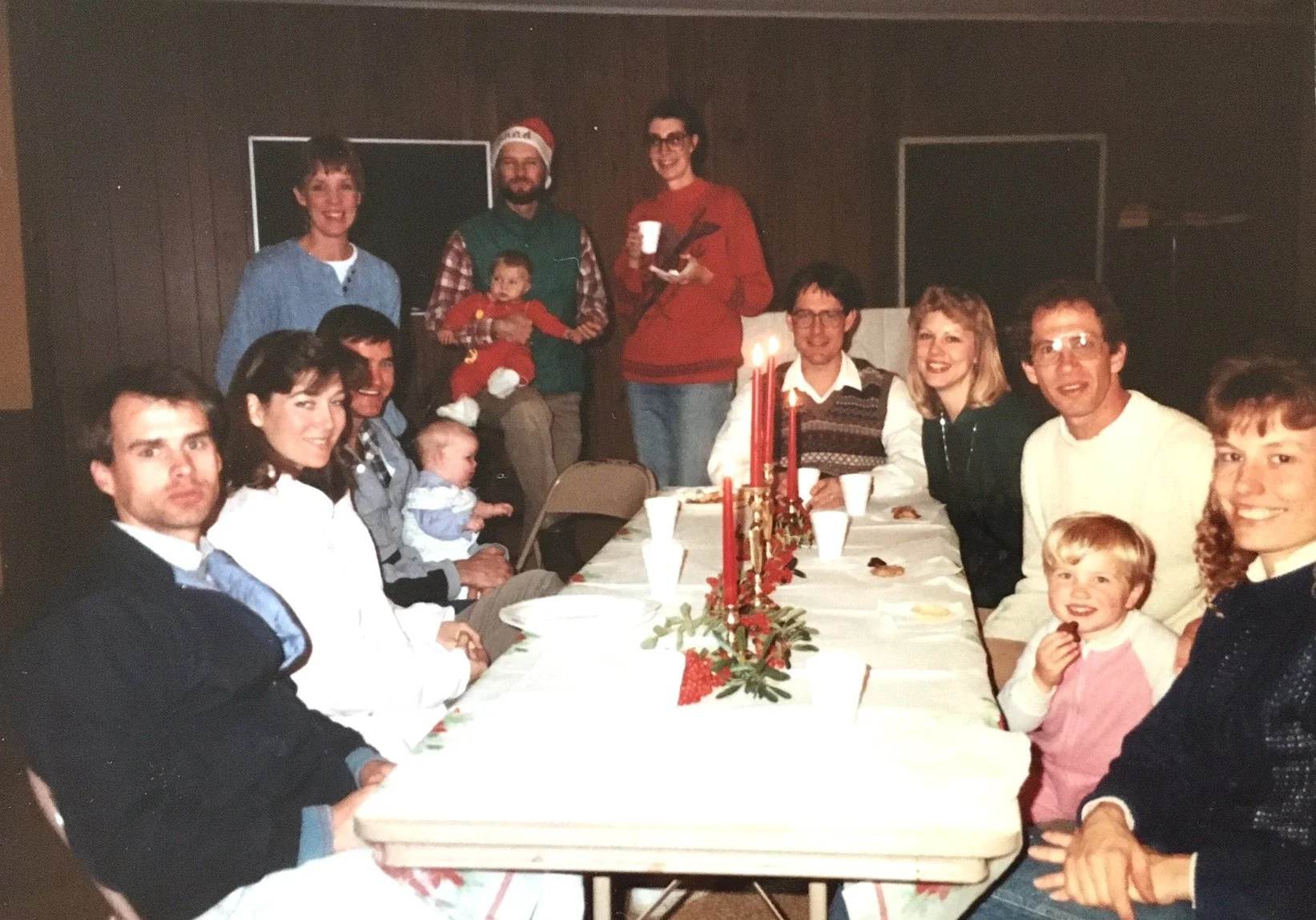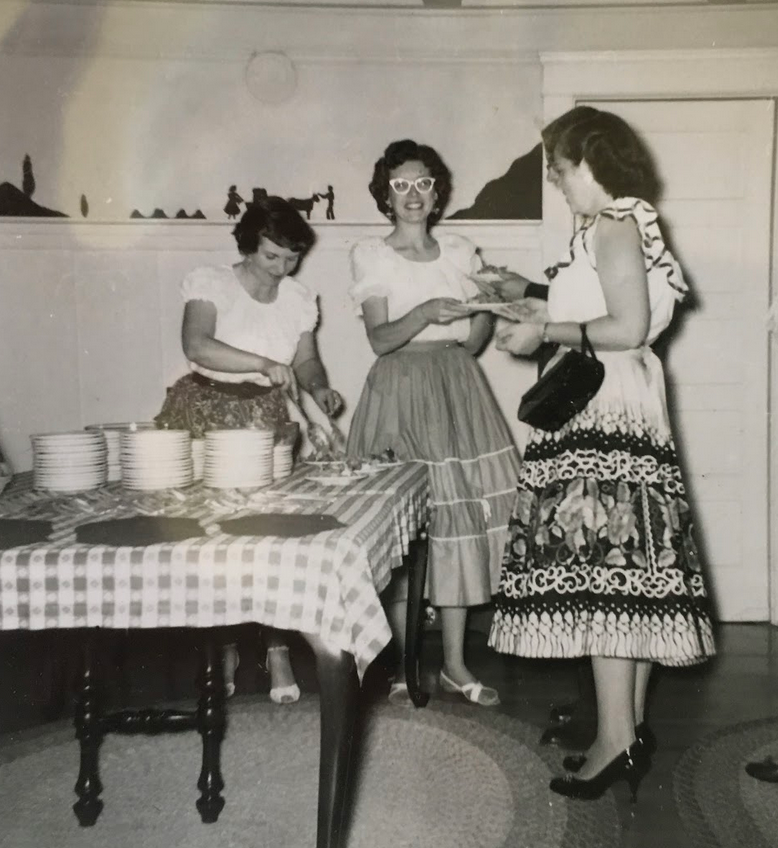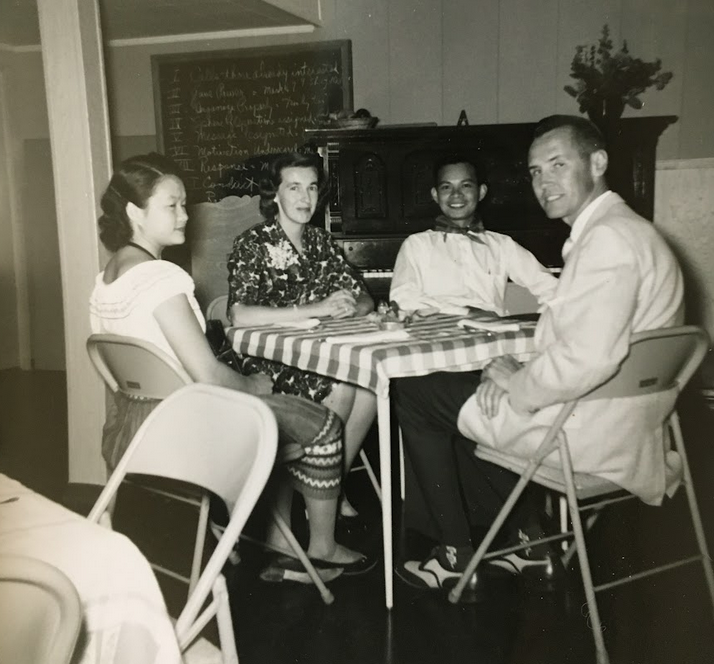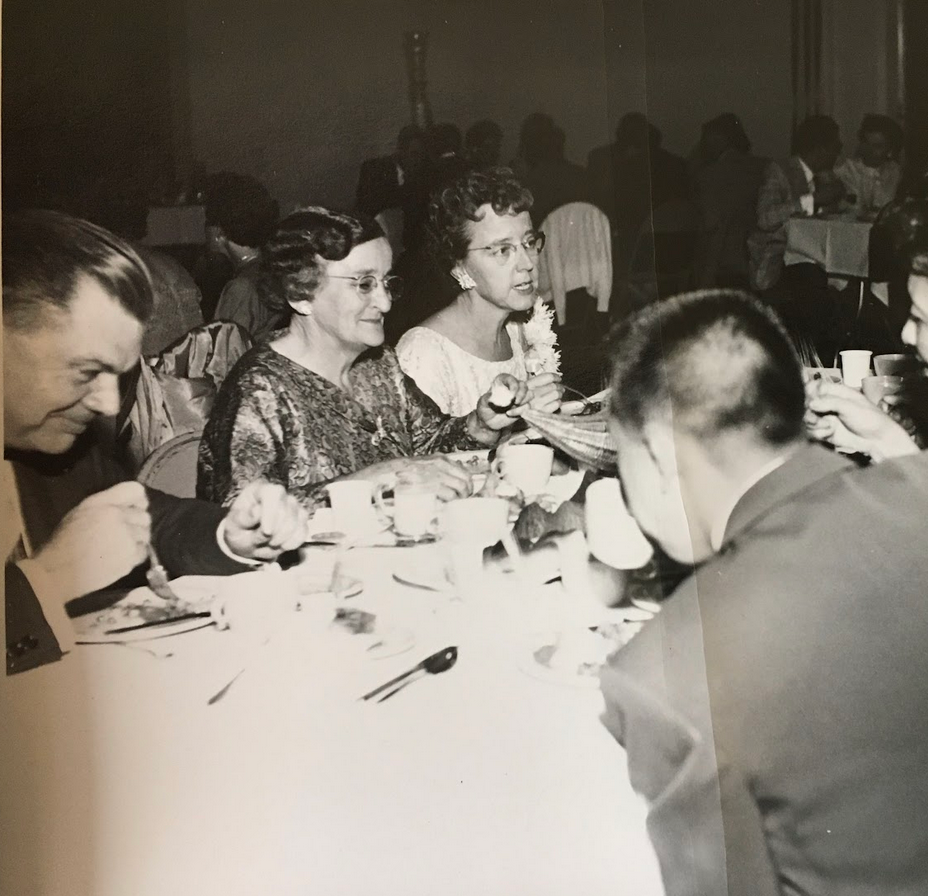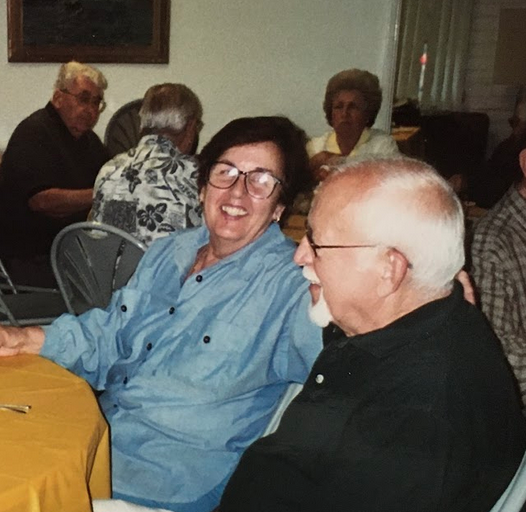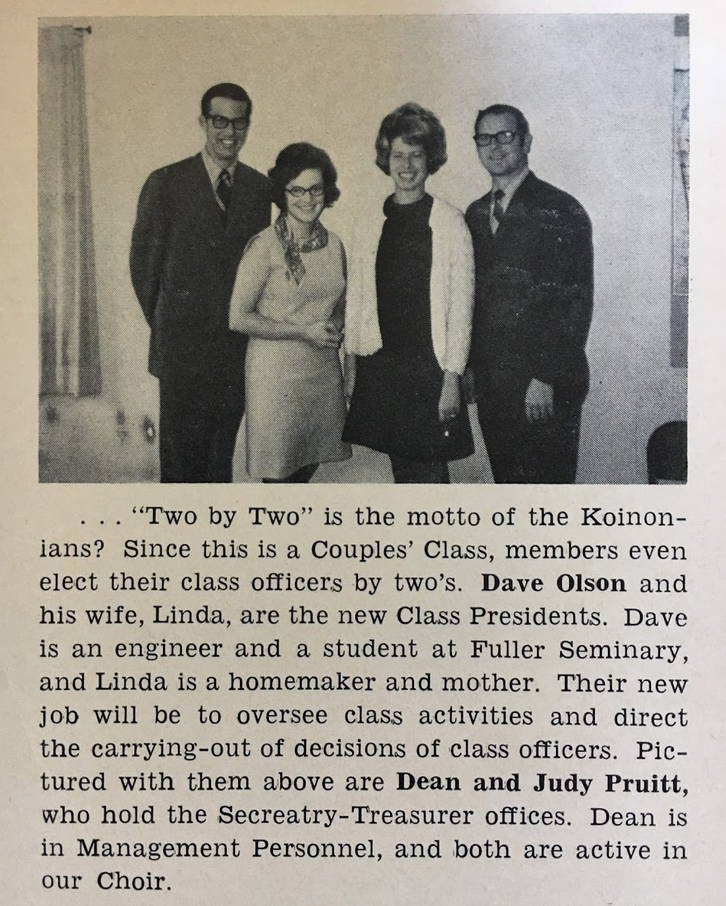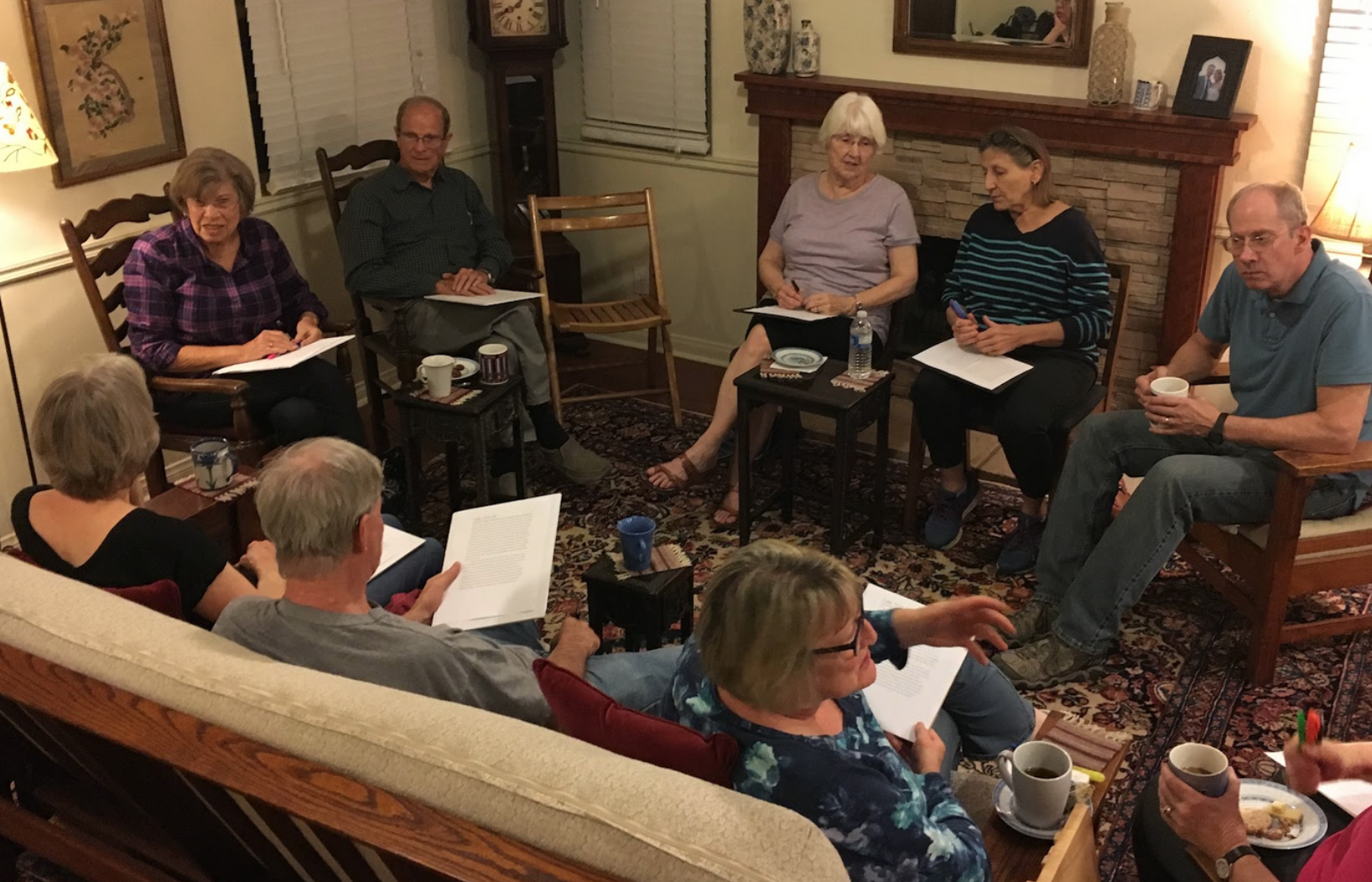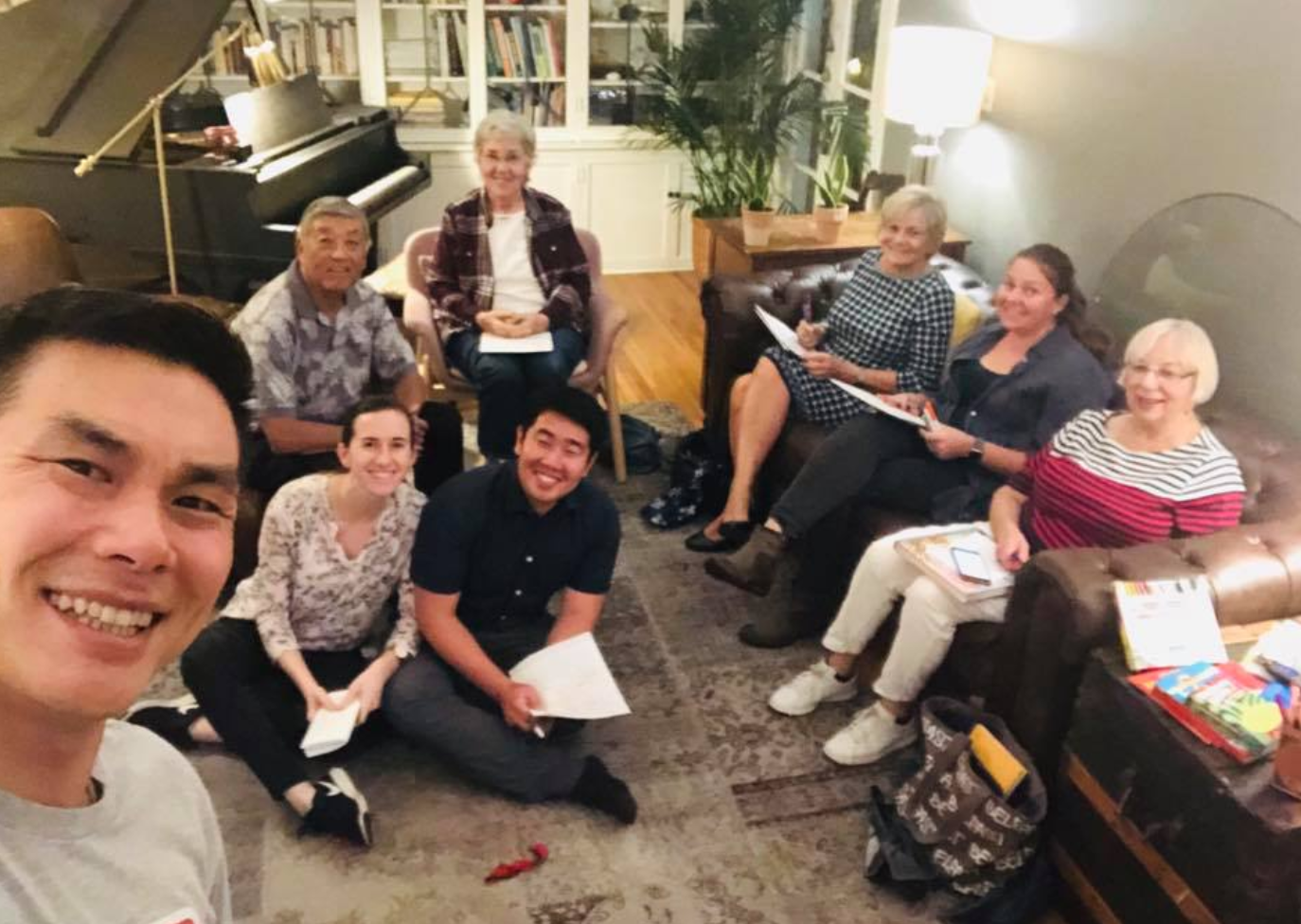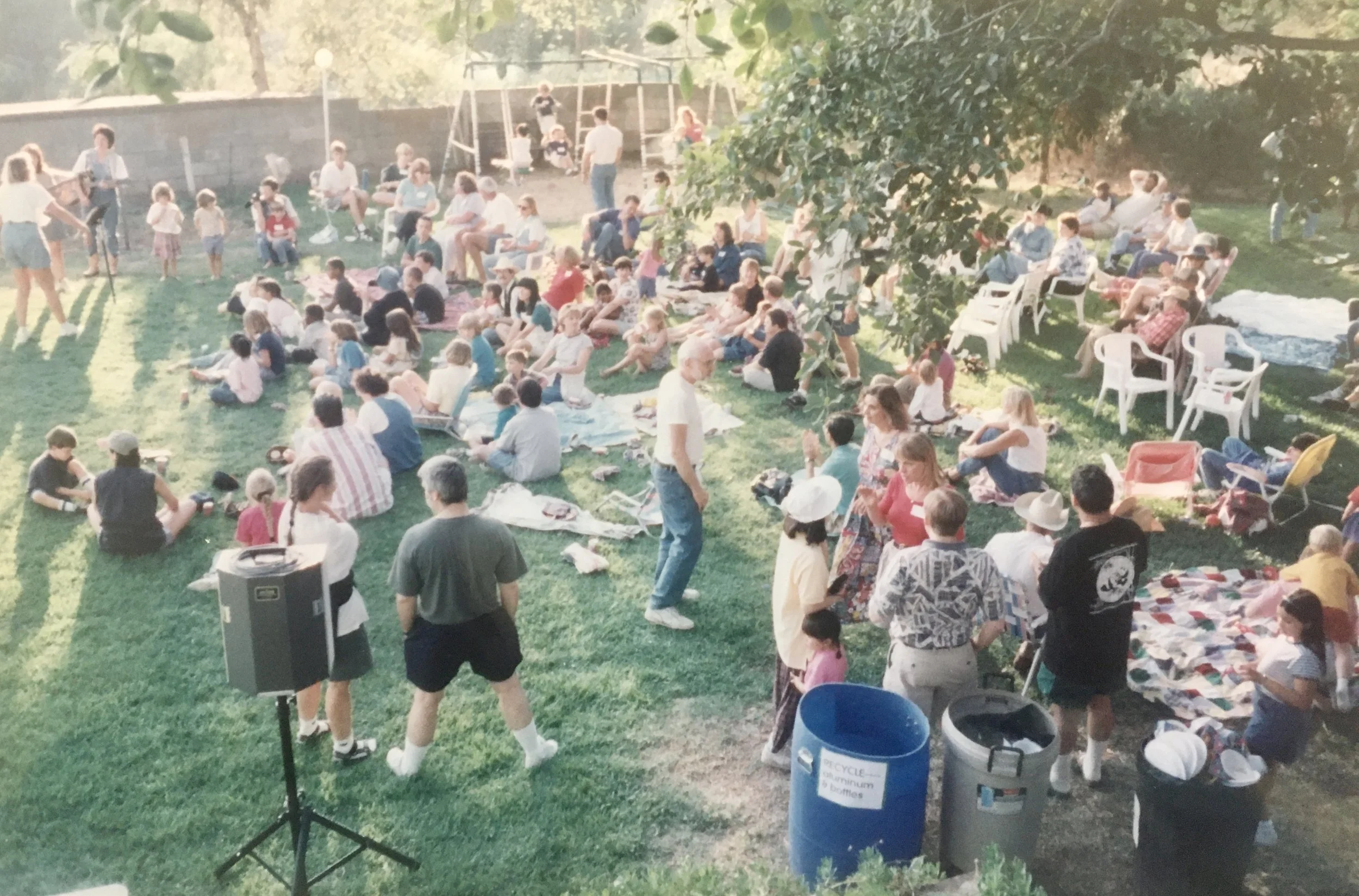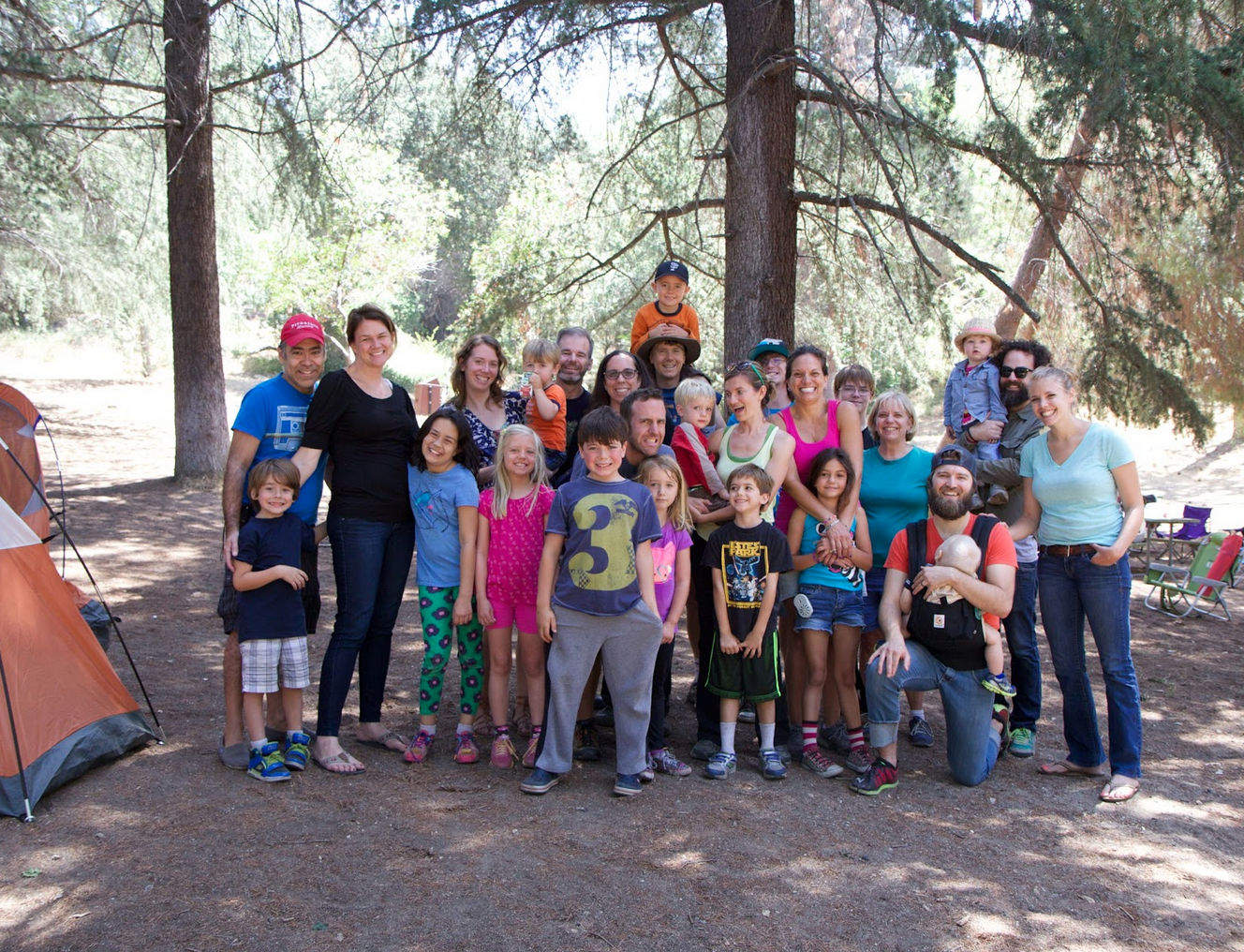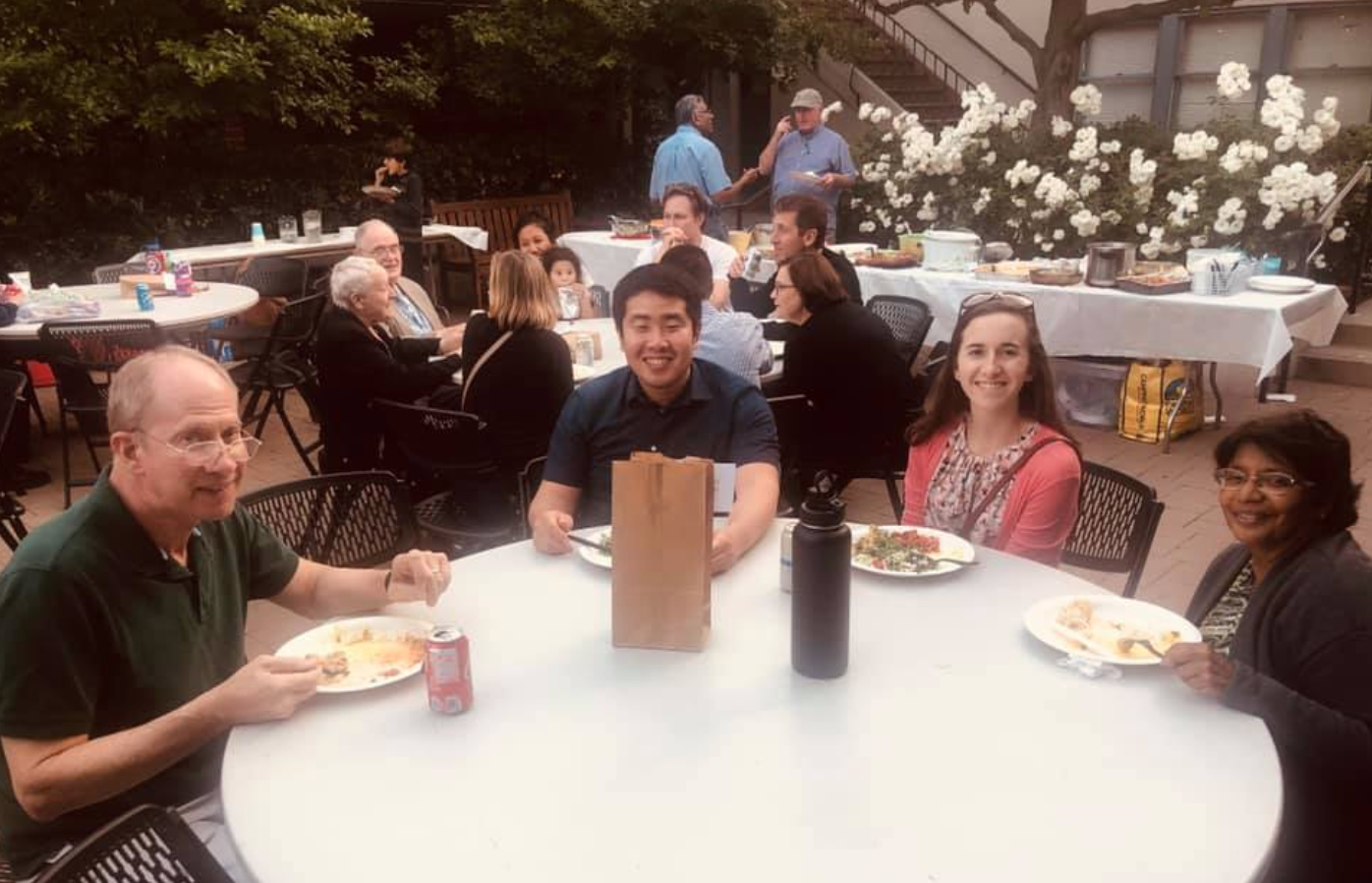Community and Connection
Being in community with one another has been a core value for Pasadena Covenant since before the church was even founded. The Pietist movement, out of which our denomination grew, started with small groups which gathered in homes. They referred to themselves as Mission Friends. Elmer Fredrickson, who began attending the church in 1924 at the age of 2, wrote a history of Pas Cov in 2005 in which he says, “The church pioneers…were hospitable and outgoing to strangers, neighbors, friends, and relatives. They desired to love everyone for Christ’s sake.” (You can read his history here: part 1 and part 2.) A bulletin cover from 1947 refers to a “warm-hearted church.” A 1971 newsletter used the tagline “the church with a heart in the heart of the city” to highlight the heartfelt fellowship here. “Caring” was one of four elements introduced in a new theme in 1975 and used for more than a decade. The fellowship-focused logo from 1989 to ~ 2000 was “One Family Together.” Fellowship and community through family-oriented activities was covered in an earlier post. Here the focus will primarily be on adult Sunday school classes and small groups.
Covenant Women
The oldest fellowship group in the church—started in 1921 before the church even began—consisted of 11 women: the Mission Friends Women’s Society. Their rules (at each monthly meeting serve coffee and not more than three treats) reflected simplicity and equality. Their dues (25 cents a month) enabled them to provide the church with new hymn books. Their emphasis not only on socializing, but on helping others, prompted them to change their name to the Phoebe Society (see Romans 16:2).
Phoebe Society picnic, 1924
By 1950 they had 80 members who “came apart from our daily duties and cares” to “be blessed, refreshed, and strengthened” by God. They also engaged in considerable acts of service.
In 1955 the group changed its name to Covenant Women’s Auxiliary. They divided into circles or small groups that met in homes and offered a better opportunity for close friendship. One woman wrote, “It is so easy to get acquainted around the work table”—work that included rolling bandages and sewing gowns for mission hospitals as well as other service-oriented crafts. By 1960 Covenant Women or CW had 175 members, meeting in seven circles. Their monthly events included a day of missions, a mother-daughter banquet, breakfast at Farnsworth Park, and a fall festival. They continued sewing and quilting for others, helping with church activities, and engaging in fundraisers so they could provide for church needs and support missionaries.
In 1977 CW started their best fundraiser ever, the Lucia Fest (which eventually served 500 at two settings and raised $5000 annually). (Lucia photos are in the post on Language & Ethnicity.) In the 1980s there were fewer circles: just the Mary and Martha Circle (it included childcare for young mothers), Mission Heirs, and Sarah Circle. CW later began a Thursday evening fellowship and an early morning Bible study for working women. Innovations in the 1990s and 2000s were the Women’s Book Club, a spring tea, and half-day retreats. The church could still count on Covenant Women for farewell receptions, memorial services, staff baby showers, and pies after the Thanksgiving service, but the giants of CW like Elsa Lund and Lucille Peterson Johnston had died, retired, or moved. The last year for the official CW was in 2010 though there are women who still gather, for example, making quilts. One of their last initiatives was a 12-week “Friendship Groups” program—a great ending to a group that started with eleven women who sought friendship with each other as they served God. (Here’s a longer version of CW history.)
And what about men?
A Covenant Men’s Fellowship was started in 1952 and functioned sporadically till 1970 with special dinners, speakers, and father-son events. There have also been periodic retreats, informal get-togethers, and a book club.
Men’s retreat at Alpine Camp, 1980s
Golden Years
Active for several decades from the 1960s into the 1980s, Golden Years was a group that ministered to senior members of the church. Facilitated at first in 1960 by Minister of Visitation, David H. Scott, it soon became very active, with monthly meetings that averaged 60 men and women. Their stated goal was to sponsor devotional, social, and recreational activities to alleviate loneliness and encourage people to bring friends to church and to Christ. Their monthly meetings featured inspirational speakers and travelogues, and refreshments with a special table set aside for those who had birthdays that month. They sponsored bus trips several times a year to places like Solvang, San Diego, Palm Springs, Catalina, and Long Beach (often with singing on the way). A highlight was the annual Christmas party at Eric’s Smorgasbord in Glendora. Church reports referred with gratitude to the way the Golden Years handymen helped keep up the buildings. A men’s shuffleboard team that played in the gym was still going in 1990.
Adult Sunday School Classes
Records in the 1950s briefly mention having 200 people in the adult Sunday school program, but it was in the 1960s that records started to give details about peer-group adult classes on Sunday morning. They were a source of growth in both faith and friendship. A newsletter in 1967 mentioned the following classes: Koinonia (couples in their 20s), Bereans (people in their 30s), Couriers (formed in the 1940s for young adults, and at that point mostly people in their 40s), Fellowship (people with grown children), and Friendship (people in their later years). Groups for single young adults included SAY in the 1970s and SALT Co as well as Prime Time in the 1980s. In 1982 a new group was formed for young couples, Joint Heirs. Other groups people might remember are 60 Minutes and Pacesetters. There were also periodic elective classes on topics such as parenting, Sabbath rest, or the Minor Prophets. By 1990, cross-age adult classes had started to predominate, including Homeroom 539 (led by Wayne Aoki) and Life Together (led by Anita Sorenson).
The classes were a place for teaching, Bible study, and discussion on Sunday mornings. (For more details on the teaching, see the post script at the end of this post.) They were also a place for dinners, game nights, excursions to the theater or a concert, camping, volleyball, hikes, pool parties, and service activities.
Some classes faded as people moved away from the area or chose to be involved in a cross-age class. Now adult Sunday School classes have for the most part been replaced by small groups. However, the Couriers are still meeting with a Bible teacher. And another one which has lasted from the 1960s till now is Koinonia. It has stopped meeting as a Sunday morning class, but the group still has monthly potlucks. Through the years, members have shared milestones both happy and sad across the life span—the birth of children, raising teenagers, the empty nest, retirement, aging parents, deaths, and the infirmities of age.
Small Groups
Over the years there have been many variations on small groups that meet at church or in homes for fellowship and spiritual growth. They have gone by different names: care groups, cell groups, life groups, and growth groups. Sometimes they have used a curriculum like Laymen’s Bible Study, Honeycomb Bible Studies or Companions in Christ, and other times have been more flexible. Some have been temporary, and others have met over the course of years. Some have been part of an official church program and others have been more organic.
One example is the Family Friendly group. Melissa Heuer writes, “In 2015 a group of families started meeting regularly to have playdates with their young children. Over time, we became a community group that ate dinner together and spent time sharing, studying, and praying together, while the children played in the backyard. Realizing we would benefit from the wisdom and experience of older couples, we invited a few to join our group. We are now seventeen families ranging from newly married twenty-somethings to empty nesters in their seventies and eighties.” And one of the older couples, Judy & Jack Balswick, added, “We have been delighted to get to know the younger families and their children as well as to have the spiritual sharing and prayer times. During the 2020 Covid crisis, many of these families came forward to do our grocery shopping to ensure our safety as elder adults. We have been richly blessed!”
Church Events
The church has also tried to build community with larger fun church events such as picnics, dinners, parties, and camp-outs. The previous post on Families also mentioned some of these special events.
Beyond 100
Our lives are busy, full, and fragmented—but our need for community remains, especially authentic community where we can be real with each other. How can the church in the next decades be a place of belonging, fellowship, friendship, and the spiritual growth that can only come when we are connected with others?
We are so grateful to the many who have sought to follow God over the past century,
and now we seek to imitate their faith for the next hundred years.
Please join us in giving to this legacy of faithfulness!
P.S.
The focus of this post has been on community and fellowship, but readers may also be interested in the content of the adult Sunday School classes.
Some classes had regular teachers who did Bible exposition, e.g., Ray Hahn Jr. (on the board at Fuller Seminary) who taught the Bereans in the 1960s, or Del Hanson (philosophy professor at Biola University) who taught the Fellowship Class in the 1970s and the Couriers in the 1980s and 1990s. John Wipf has been a recent Bible teacher for the Couriers. Other classes rotated teachers from among their members. Teachers for Joint Heirs, for example, included Warren Thomas on stewardship, Lee Purgason on being blessed to bless others, Paul Woodward on balancing work and leisure, and Carolyn Johnson on the book of Luke.
Some classes had leaders who were more discussion facilitators. Anita Sorenson led the Life Together group to read articles or chapters and then discuss topics such as spiritual friendship, contemplative practices, spiritual disciplines, community, forms of prayer, calling and mission, and liturgy.
Starting in the 1970s there have also been elective classes, taking advantage of the expertise of church members or other guest speakers such as Walt Wright, Cedric B Johnson, Leslie Allen, and Naomi Johnston. Some were on topics such as “Marketplace Christianity,” “Homelessness in Pasadena,” “Creativity in Work, Play, and Worship,” “Christian Self-Esteem,” “Sabbath Rest,” “Issues in Parenting” and “Grace.” Others were on books of the Bible (e.g., I Peter, Galatians, the Gospel of Mark, Psalms, and Minor Prophets).

